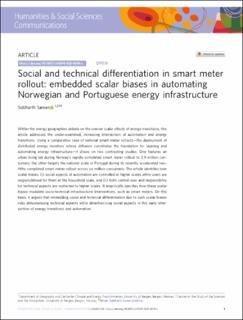| dc.contributor.author | Sareen, Siddharth | |
| dc.date.accessioned | 2021-07-15T12:18:30Z | |
| dc.date.available | 2021-07-15T12:18:30Z | |
| dc.date.created | 2020-12-23T10:41:29Z | |
| dc.date.issued | 2020 | |
| dc.identifier.issn | 2662-9992 | |
| dc.identifier.uri | https://hdl.handle.net/11250/2764533 | |
| dc.description.abstract | Within the energy geographies debate on the uneven scalar effects of energy transitions, this article addresses the under-examined, increasing intersection of automation and energy transitions. Using a comparative case of national smart meter rollouts—the deployment of distributed energy monitors whose diffusion constitutes the foundation for layering and automating energy infrastructure—it draws on two contrasting studies. One features an urban living lab during Norway’s rapidly completed smart meter rollout to 2.9 million consumers; the other targets the national scale in Portugal during its recently accelerated two-fifths completed smart meter rollout across six million consumers. The article identifies twin scalar biases: (i) social aspects of automation are controlled at higher scales while users are responsibilised for them at the household scale, and (ii) both control over and responsibility for technical aspects are restricted to higher scales. It empirically specifies how these scalar biases modulate socio-technical infrastructural interventions, such as smart meters. On this basis, it argues that embedding social and technical differentiation due to such scalar biases risks dehumanising technical aspects while detechnicising social aspects in this early intersection of energy transitions and automation. | en_US |
| dc.language.iso | eng | en_US |
| dc.publisher | Springer | en_US |
| dc.rights | Navngivelse 4.0 Internasjonal | * |
| dc.rights.uri | http://creativecommons.org/licenses/by/4.0/deed.no | * |
| dc.title | Social and technical differentiation in smart meter rollout: embedded scalar biases in automating Norwegian and Portuguese energy infrastructure | en_US |
| dc.type | Journal article | en_US |
| dc.type | Peer reviewed | en_US |
| dc.description.version | publishedVersion | en_US |
| dc.rights.holder | Copyright the author | en_US |
| dc.source.articlenumber | 25 | en_US |
| cristin.ispublished | true | |
| cristin.fulltext | original | |
| cristin.qualitycode | 1 | |
| dc.identifier.doi | 10.1057/s41599-020-0519-z | |
| dc.identifier.cristin | 1863025 | |
| dc.source.journal | Humanities & Social Sciences Communications | en_US |
| dc.identifier.citation | Humanities & Social Sciences Communications. 2020, 7, 25. | en_US |
| dc.source.volume | 7 | en_US |

